Best Ice Cleats
Our lab tests show that these spiky traction devices really can help prevent slips and falls in winter weather
When you shop through retailer links on our site, we may earn affiliate commissions. 100% of the fees we collect are used to support our nonprofit mission. Learn more.
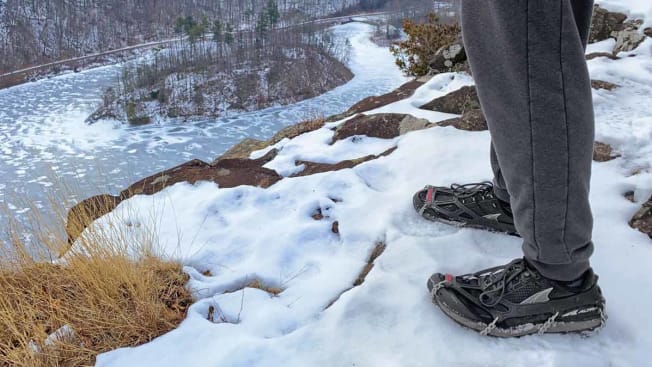
I don’t love trudging around in winter weather, especially after several near-falls on treacherous black ice while walking Dolce, my 8-year-old Cavalier King Charles Spaniel. That’s why I’m adding ice cleats to my winter dog-walking uniform. Ice cleats (also known as ice spikes, crampons, Nanospikes, or Microspikes) attach to your shoes with rubber harnesses and/or straps and have spikes or screw heads that dig into the ice to keep walkers—and even runners—from slipping on ice and eating the pavement or suffering serious harm. In the U.S. alone, thousands of people are injured each year from falls on ice, slush, or snow.
Do Ice Cleats Really Work?
Short answer: Yes. While they’re bulky-looking and certainly won’t be an Instagram trend any time soon, they can definitely save your butt. Consumer Reports recently tested several popular ice cleat models for effectiveness.
What Our Testers Found
CR tested five models that fit a men’s size 9 shoe or boot. But all are available in a range of sizes to fit your footwear.
Four models—the Kahtoolas, Sportneers, Stabils, and Yatta—offered excellent grip on ice in our lab tests. The Yaktrax, however, didn’t perform as well as the others, especially on sloped ice, because of its less aggressive hardware, according to the testers.
They also said that ice cleats perform best when stepping firmly, which drives the tips of the metal spikes or screws into the surface of the ice, offering better grip than when stepping more gently. Users should also be careful on sloped hard surfaces such as solid rock. The spikes have nowhere to grip, making these surfaces potentially more hazardous to walk on with these devices than ice.
Finally, the spikes aren’t actually as pointy and sharp as they appear. And most come with a handy case for easy storage and to keep them from nosy pets and small children.
Kahtoola Microspikes Footwear Traction
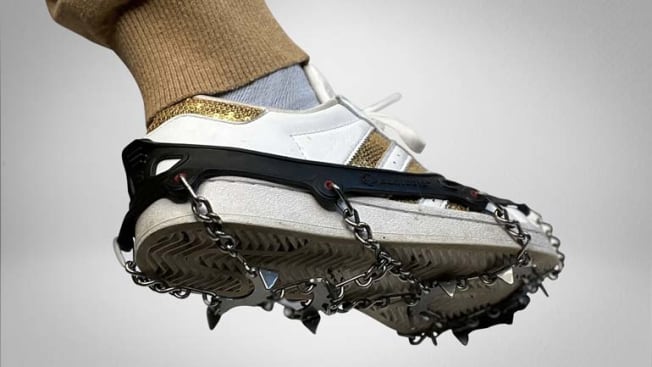
Photo: Ginger Cowles/Consumer Reports Photo: Ginger Cowles/Consumer Reports
The Kahtoola Microspikes offered the least-stable stance on hard surfaces because of the narrow spacing of the spikes in the heel area, but they excelled when testers ran on snow- and ice-covered trails. As a first-time user of ice cleats, I found these to be the easiest to put on and remove—even while rushing to do so in my car.
Driving-while-ice-cleating was a non-issue. After my walk and in a hurry to drive back home to finish up my workday, I accidentally left these on and didn’t notice until just before I exited the park where I had been walking. To my surprise, the cleats didn’t affect my ability to maneuver between the gas and brake pedals.
Sportneer Ice Cleats (with Velcro straps)
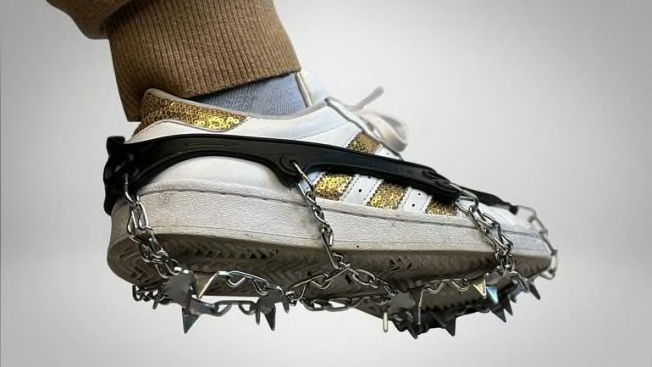
Photo: Ginger Cowles/Consumer Reports Photo: Ginger Cowles/Consumer Reports
Sportneer Ice Cleats are very similar to the Kahtoola cleats, with a slightly more stable rearfoot. They have Velcro straps to keep them more firmly attached to footwear.
Shop: Amazon, $15.99
Stabil Stabilicers Maxx2
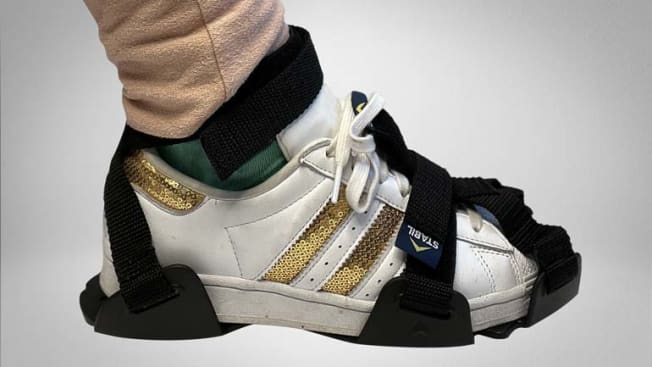
Photo: Ginger Cowles/Consumer Reports Photo: Ginger Cowles/Consumer Reports
Stabilicers Maxx2 cleats offered the most stable stance because the screw heads that grip ice are spaced the farthest apart. At 10.7 ounces, they were also the heaviest. Testers thought they would be best for people who may have limited hand strength because the Velcro straps make these easier to attach to footwear.
Compared to the models without Velcro straps, this one took me slightly longer to put on, because you have to thread the strap through the designated areas of the cleat. As someone who is new to ice cleats, this did not bother me, but I could see it being slightly annoying to people who use them often.
Shop: Backcountry Gear, Liberty Mountain, and Stabil, $64.99
Yaktrax Diamond Grip
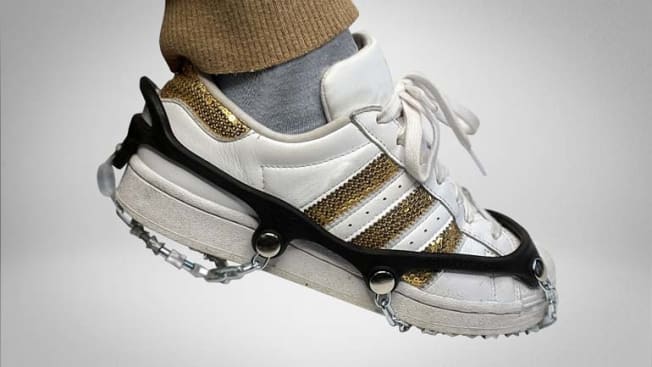
Photo: Ginger Cowles/Consumer Reports Photo: Ginger Cowles/Consumer Reports
The Yaktrax Diamond Grip didn’t grip as well as the others but still provided improved traction. They’re best for walking on cleared pavement where you may occasionally encounter slick surfaces.
Shop: REI, $54.99
Yatta Life Heavy-Duty Trail Spikes (with Velcro straps)
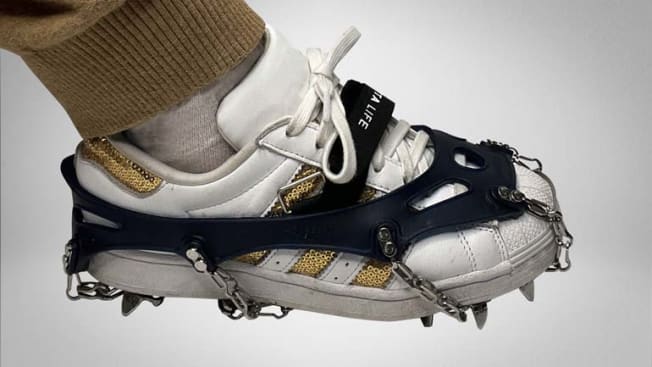
Photo: Ginger Cowles/Consumer Reports Photo: Ginger Cowles/Consumer Reports
The Yatta Life Heavy-Duty Trail Spikes are very similar to the Kahtoola, with a slightly more stable rearfoot like the Sportneer. They include Velcro straps to keep them more firmly attached to shoes.
Shop: Amazon, $64.95
Ice Spikes for Running
Testers tried three of the models running on a snowy, icy trail: Kahtoola Microspikes, the Yatta Life Heavy-Duty Trail Spikes, and the Sportneer Ice Cleats. All had incredible grip, and the testers reported that they could run at a quick pace without fear of slipping. “I easily ran up and down steep ice-covered hills with better traction than I would have on a summer day,” says Jake Fisher, a triathlete and CR’s senior director for auto testing.
CR’s Final Take
If you want very effective traction under the widest variety of ice conditions and use, all but the Yaktrax are excellent choices. The Stabil Maxx2 may be easier to use for those with limited hand strength because they don’t require you to stretch the device over a shoe—and offer the most stable feel in use, though they’re relatively heavy. The Stabil Maxx2 also doesn’t rely on elastic tension to stay on your footwear. Those with rubber harnesses may come off under some conditions (but didn’t during our testing).
How We Tested Ice Spikes
Ease of use: First, testers put them on over their shoes and boots, evaluating how easy it was to do so, as well as how easy they were to remove.
Four of the five—all but the Stabil Maxx2—have rubber shoe harnesses, which are stretched over the toe and heel of the shoe or boot to hold the traction device in place. Two of them—the Sportneer and the Yatta Life—have Velcro straps that tighten over the midfoot to hold the sides of the harness more firmly in place. The Stabil Maxx2 uses a sole plate with a raised edge and Velcro straps to position itself on the footwear.
Using the rubber shoe harnesses requires sitting down and stretching them over the shoes, which may be difficult for those with hand strength issues. The Stabil is attached with just Velcro, which is easier to use but results in a looser connection to footwear, because its sole plate is rigid and because the sole plate may be larger than the soles of either the shoes or boots used.
All were easy to remove; wearing gloves while doing so made it marginally harder. But once in place, all of the models remained on the shoes or boots and didn’t interfere with removing or putting on the footwear.
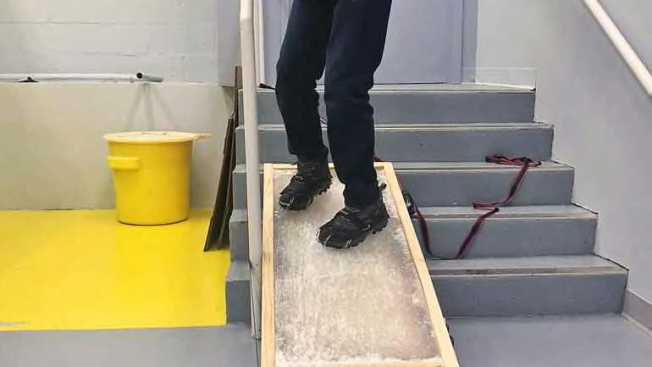
Photo: Bernie Deitrick/Consumer Reports Photo: Bernie Deitrick/Consumer Reports
Walking while wearing the devices: Testers walked on vinyl tiles, carpet, and painted floors to evaluate how well the cleats worked when not on ice, and to see if there were any problems with wearing them on hard surfaces. They varied their walking pace as well as their weight distribution while planting their feet to evaluate the grip each model provided.
Then testers wore them while walking on ice. To have a consistent ice experience, they used a sheet of thick ice, about 2 feet by 4 feet, that was within a wooden frame. They also walked on a slope of ice created by propping it on a staircase in one of our labs, allowing us to simulate very slippery conditions (ice on steps or sloped sidewalks and driveways) but with the use of a handrail for support to prevent them from falling.
Testers also wore the devices while walking in the remains of a winter snowstorm and rainstorm that left sidewalks covered in frozen slush (sections that hadn’t been shoveled); covered in sheet ice (sections that had been shoveled but had water pooled or flowing over); or bare (shoveled sections that drained well).
Running while wearing the devices: Runners ran several miles on snow- and ice-covered trails wearing the Kahtoola Microspikes, the Yatta Life Heavy-Duty Trail Spikes, and the Sportneer Ice Cleats.
















